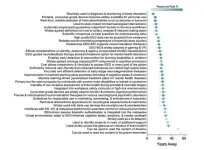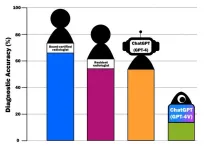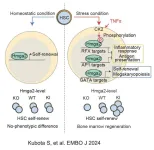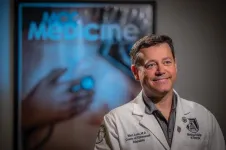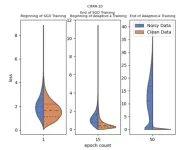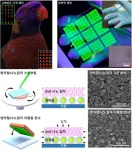(Press-News.org) Researchers from North Carolina State University and Johns Hopkins University have demonstrated a technology capable of a suite of data storage and computing functions – repeatedly storing, retrieving, computing, erasing or rewriting data – that uses DNA rather than conventional electronics. Previous DNA data storage and computing technologies could complete some but not all of these tasks.
“In conventional computing technologies, we take for granted that the ways data are stored and the way data are processed are compatible with each other,” says project leader Albert Keung, co-corresponding author of a paper on the work. “But in reality, data storage and data processing are done in separate parts of the computer, and modern computers are a network of complex technologies.” Keung is an associate professor of chemical and biomolecular engineering and a Goodnight Distinguished Scholar at NC State.
“DNA computing has been grappling with the challenge of how to store, retrieve and compute when the data is being stored in the form of nucleic acids,” Keung says. “For electronic computing, the fact that all of a device’s components are compatible is one reason those technologies are attractive. But, to date, it’s been thought that while DNA data storage may be useful for long-term data storage, it would be difficult or impossible to develop a DNA technology that encompassed the full range of operations found in traditional electronic devices: storing and moving data; the ability to read, erase, rewrite, reload or compute specific data files; and doing all of these things in programmable and repeatable ways.
“We’ve demonstrated that these DNA-based technologies are viable, because we’ve made one.”
The new technology is made possible by recent techniques that have enabled the creation of soft polymer materials that have unique morphologies.
“Specifically, we have created polymer structures that we call dendricolloids – they start at the microscale, but branch off from each other in a hierarchical way to create a network of nanoscale fibers,” says Orlin Velev, co-corresponding author and the S. Frank and Doris Culberson Distinguished Professor of Chemical and Biomolecular Engineering at NC State. “This morphology creates a structure with a high surface area, which allows us to deposit DNA among the nanofibrils without sacrificing the data density that makes DNA attractive for data storage in the first place.”
“You could put a thousand laptops’ worth of data into DNA-based storage that’s the same size as a pencil eraser,” Keung says.
“The ability to distinguish DNA information from the nanofibers it’s stored on allows us to perform many of the same functions you can do with electronic devices,” says Kevin Lin, first author of the paper and a former Ph.D. student at NC State. “We can copy DNA information directly from the material’s surface without harming the DNA. We can also erase targeted pieces of DNA and then rewrite to the same surface, like deleting and rewriting information stored on the hard drive. It essentially allows us to conduct the full range of DNA data storage and computing functions. In addition, we found that when we deposit DNA on the dendricolloid material, the material helps to preserve the DNA.”
“You could say that Keung’s team is providing the equivalent of microcircuits, and the dendricolloidal material that my team creates provides the circuit board,” says Velev. “Our NC State collaborator Adriana San Miguel helped us incorporate the materials into microfluidic channels that direct the flow of nucleic acids and reagents, allowing us to move data and initiate computing commands. Winston Timp’s lab at Johns Hopkins contributed their expertise on nanopore sequencing, which helps us directly read the data in RNA after copying it from DNA on the material’s surface. And James Tuck’s lab – also here at NC State – has developed algorithms that allow us to convert data into nucleic acid sequences and vice versa while controlling for potential errors.”
The researchers have demonstrated that the new data storage and computing technology – which they call a “primordial DNA store and compute engine” – is capable of solving simple sudoku and chess problems. And testing suggests that it could store data securely for thousands of years in commercially available spaces without degrading the information-storing DNA.
“What’s more, the dendrocolloidal host material itself is relatively inexpensive and easy to fabricate,” Velev says.
“There’s a lot of excitement about molecular data storage and computation, but there have been significant questions about how practical the field may be,” says Keung. “We looked back at the history of computing and how the creation of ENIAC inspired the field. We wanted to develop something that would inspire the field of molecular computing. And we hope what we’ve done here is a step in that direction.”
The paper, “A Primordial DNA Store and Compute Engine,” will be published Aug. 22 in the journal Nature Nanotechnology. The paper was co-authored by Kevin Volkel and Andrew Clark, former Ph.D. students at NC State; Cyrus Cao and Rachel Polak, Ph.D. students at NC State; Adriana San Miguel, an associate professor of chemical and biomolecular engineering at NC State; James Tuck, a professor of electrical and computer engineering at NC State; Winston Timp, an associate professor of biomedical engineering at Johns Hopkins University; and Paul Hook, a postdoctoral researcher at Johns Hopkins.
The work was done with support from the National Science Foundation under grants 2027655 and 1901324.
Keung and Tuck are co-founders of DNAli Data Technologies, so have potential interest in translating and commercializing DNA-based information systems. Keung, Volkel, Tuck, and Lin are inventors on patent application WO 2020/096679, which has been licensed to DNAli Data Technologies and from which some of this work is derived.
END
For first time, DNA tech offers both data storage and computing functions
2024-08-22
ELSE PRESS RELEASES FROM THIS DATE:
Will EEG be able to read your dreams? The future of the brain activity measure as it marks 100 years
2024-08-22
One hundred years after the human brain’s electrical activity was first recorded, experts are celebrating the legacy of its discovery and sharing their predictions and priorities for its future.
Since the first recording in July 1924, human electroencephalography (EEG) has been integral to our understanding of brain function and dysfunction: most significantly in the clinical diagnosis of epilepsy, where the analysis of the EEG signal meant that a condition previously seen as a personality disorder was quickly redefined as a disorder of brain activity.
Now, a century on, more than 500 experts from around the globe, ...
Investigating the role of interhemispheric pathways in motor recovery
2024-08-22
Stroke and spinal cord injuries can severely impair motor functions, and understanding how to promote recovery is a critical challenge. While damaged neurons in the brain and spinal cord have limited ability to regenerate, the brain can form or strengthen alternative neural pathways involving uninjured parts of the brain, enabling functional recovery. Such reorganization of pathways in the brain is called neural plasticity, and identifying the involved pathways and understanding their functions can ...
Clinical trial in Ireland challenges beliefs about Ozempic and similar new obesity treatments
2024-08-22
A study carried out in St Vincent’s University Hospital (SVUH) Dublin challenges the belief that weight loss medications such as Ozempic, Wegovy or Monjaro work just by promoting satiety and making you eat less.
The randomized controlled trial with 30 patients was led by Professor Donal O’Shea, SVUH and UCD School of Medicine, and examined the family of medications based on the hormone Glucagon-like peptide-1 (GLP-1).
The findings published today in the Journal of the Obesity Society shows that there is a strong relationship between the increase in metabolic ...
Mouse study: Proteins do the damage in fetal abdominal inflammation
2024-08-22
Inflammation of the abdominal cavity in human fetuses resulting from a perforation of their intestine is likely to be caused by proteins contained in the fetal stool. This is the result of a Kobe University study that establishes a new mouse model allowing research and drug development for a condition that is otherwise difficult to approach.
The fetus’s stool, called the “meconium,” is sterile but nevertheless causes inflammation of the abdominal cavity when it leaks out of the intestine after a perforation. Called “meconium peritonitis,” this is a life-threatening condition for the baby with a mortality rate of 10%-15% in humans, and neither a cause ...
Let me take a look: AI could boost diagnostic imaging results
2024-08-22
In radiology, diagnostic imaging requires specialized knowledge to interpret the findings associated with a wide variety of diseases. Fortunately, in recent years, generative AI models, such as Chat Generative Pre-trained Transformer (ChatGPT), have shown potential as diagnostic tools in the medical field, but their accuracy must be evaluated for optimal use in the future.
Therefore, Dr. Daisuke Horiuchi and Associate Professor Daiju Ueda of Osaka Metropolitan University’s Graduate School of Medicine led a research team that compared the diagnostic accuracy of ChatGPT and radiologists. They used 106 musculoskeletal radiology cases with patient medical history, images, ...
Prof Carl Kocher explores how you can stretch your mind to grasp quantum entanglement
2024-08-22
My new article, ‘Quantum Entanglement of Optical Photons: The First Experiment, 1964-67’, is intended to convey the spirit of a small research project that reaches into uncharted territory. The article breaks with tradition, as it offers a first-person account of the strategy and challenges for the experiment, as well as an interpretation of the final result and its significance. In this guest editorial, I will introduce the subject and also attempt to illuminate the question ‘What is a paradox?’
Let’s begin with the gyroscope that I bought when I was eight, from a store ...
Unveiling the secret of blood regeneration: New insights into stress responses in hematopoietic stem cells (HSC)
2024-08-22
Kumamoto University researchers have made a groundbreaking discovery that sheds light on how the HMGA2 gene—an essential transcriptional activator involved in chromatin modification—regulates stress responses in hematopoietic stem cells (HSCs), thereby enhancing blood cell production recovery.
Exposure to infections or treatments such as chemotherapy often leads to a rapid decline in blood cells, including red blood cells and platelets. HSCs, which reside in the bone marrow that can develop into various types of blood cells, are crucial for recovering from these stress-induced blood disorders. Under stressd ...
MCG physicians working to help prevent vision loss associated with space travel
2024-08-22
Physicians at the Medical College of Georgia at Augusta University are working with Polaris Dawn, the first of the Polaris Program’s three human spaceflight missions, to better understand the eye changes many astronauts experience during spaceflight that can leave them with a wide range of symptoms once they return to Earth — from a new need for glasses to significant loss of vision. The Polaris Program is a first-of-its-kind effort to rapidly advance human spaceflight capabilities while continuing to raise funds and awareness for important causes on Earth.
More than 70% of astronauts experience a phenomenon ...
Adaptive-k: A simple and effective method for robust training in label noisy datasets
2024-08-22
Training deep learning models on large datasets is essential for their success; however, these datasets often contain label noise, which can significantly decrease the classification performance on test datasets. To address this issue, a research team consisting of Enes Dedeoglu, H. Toprak Kesgin, and Prof. Dr. M. Fatih Amasyali from Yildiz Technical University developed a groundbreaking method called Adaptive-k, which improves the optimization process and yields better results in the presence of label noise. Their research was published on 15 August 2024 in ...
Developing innovative new display technologies! Create ultrahigh-definition screens efficiently!
2024-08-22
□ A team led by Professor Ji-woong Yang of DGIST’s (President Kun-woo Lee) Department of Energy Science and Engineering, in collaboration with Professor Moon-kee Choi of UNIST's Department of New Materials and Dr. Taeg-hwan Hyun of the IBS Nanoparticle Research Center, has developed a double-layer dry transfer printing technology that simultaneously transfers light-emitting and electron-transferring layers onto a substrate. This technology is expected to provide a more life-like view in augmented reality (AR) and virtual reality (VR), greatly enhancing the immersive experience.
□ ...
